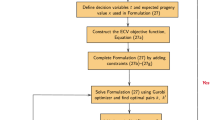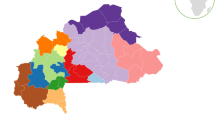Abstract
Three random samples of inbred lines, two (B and D) extracted from the V1 × V5 and V2 × V12 crosses of Nicotianarustica and the third (Dc) produced from their double cross (V1×V5)×(V2×V12), have been compared for seven quantitative characters. Theoretically, the genetical expectations of the first, second, third and fourth order statistics of these samples are expected to differ both in the absence and presence of complications like epistasis, linkage disequilibrium and genotype × environmental interactions. However, the magnitudes of these differences depend largely on the numbers of loci (kb1 and kb2) that segregate in the single crosses and on the background loci (kf) that have different alleles fixed in each pair of parents. In practice, the statistics and distributions of B, D and Dc samples differ significantly from each other for most of the characters. The statistics of the Dc sample, on the other hand, have values that often lie between those of B and D samples. In fact the statistical properties of the Dc sample are adequately mimicked by the joint distribution of the B + D inbreds except for range and intertrait correlations.
Further, the extreme recombinant inbreds from the double cross sample are not generally superior to those from the B and D samples. However, they do cover between 88 per cent to 109 per cent of the total range that is jointly covered by the extreme inbreds of the B and D samples. Theoretically the double cross is a better source when almost all of the genetic variability is contributed by the background loci (kf) and the alleles are dispersed between the two pairs of parents.
Similar content being viewed by others
Article PDF
References
Cavalli, L L. 1952. An analysis of linkage in quantitative inheritance. Quantitative Inheritance (eds E. C. R. Rieve and C. H. Waddington), H.M.S.O., London.
Eberhart, S A. 1964. Theoretical relations among single, three way and double cross hybrids. Biometrics, 20, 522–539.
Jinks, J L, and Perkins, J M. 1972. Predicting the range of inbred lines. Heredity, 28, 399–403.
Jinks, J L, and Pooni, H S. 1976. Predicting the properties of recombinant inbred lines derived by single seed descent. Heredity, 36, 253–266.
Jinks, J L, and Pooni, H S. 1980. Comparing predictions of mean performance and environmental sensitivity of recombinant inbred lines based upon F3 and triple test cross families. Heredity, 45, 305–312.
Jinks, J L, and Pooni, H S. 1981. Predicting the properties of pure breeding lines extractable from a cross in the presence of linkage. Heredity, 49, 265–270.
Jinks, J L, and Pooni, H S. 1984. Comparison of inbred lines produced by single seed descent and pedigree inbreeding. Heredity, 53, 299–308.
Mather, K. 1949. Biometrical Genetics (1st Edn.), Methuen, London.
Mather, K. 1973. Statistical Analysis in Biology. Chapman and Hall, London.
Mather, K, and Jinks, J L. 1982. Biometrical Genetics (3rd Edn.) Chapman and Hall, London.
Pooni, H S, and Jinks, J L. 1978. Predicting the properties of recombinant inbred lines derived by single seed descent for two or more characters simultaneously. Heredity, 40, 349–361.
Pooni, H S, and Jinks, J L. 1985. Predicting the properties of first cycle inbreds and second cycle hybrids extractable from two, three and four parent crosses. Heredity, 54, 397–411.
Pooni, H S, Jinks, J L, and Cornish, M A. 1977. The causes and consequences of non-normality in predicting the properties of recombinant inbred lines. Heredity, 38, 329–338.
Pooni, H S, Jinks, J L, and Jayashekara, N E M. 1978. An investigation of gene action and genotype×environment interaction in two crosses of Nicotiana rustica by triple test cross and inbred line analysis. Heredity, 41, 83–92.
Pooni, H S, Jinks, J L, and Pooni, G S. 1980. A general method for the detection and estimation of additive, dominance and epistatic variation for metrical traits. IV. Triple test cross analysis for normal families and their selfs. Heredity, 44, 177–192.
Pooni, H S, Jinks, J L, and Yohannes, D. 1985. Predicting the properties of random inbreds and second cycle hybrids using progeny families and hierarchical selfs of a four parent cross. Heredity, 55, 111–119.
Snedecor, G W, and Cochran, W G. 1974. Statistical Methods. Iowa State University Press, Ames, U.S.A.
Author information
Authors and Affiliations
Rights and permissions
About this article
Cite this article
Pooni, H., Jinks, J. & Yohannes, D. Comparison of inbred lines extracted from two single crosses and their double cross by single seed descent. Heredity 56, 263–276 (1986). https://doi.org/10.1038/hdy.1986.39
Received:
Issue date:
DOI: https://doi.org/10.1038/hdy.1986.39



